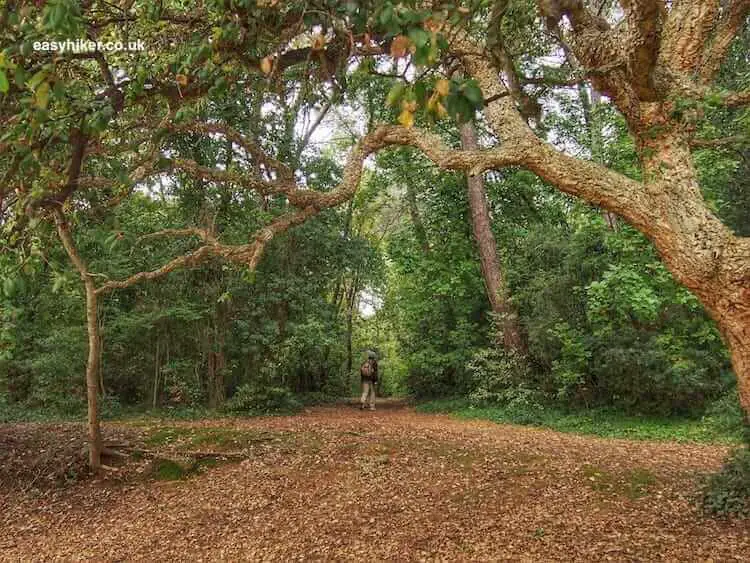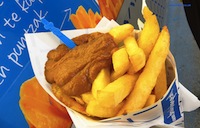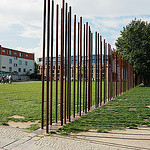There are many reasons to come to Düsseldorf. But – at a rough guess – nine out of ten people who do “touch down“ in this western German city on the Rhine do so to take off again within a couple of hours and never get to see anything beyond the airport, one of Germany’s busiest air traffic hubs.
That’s a pity because Düsseldorf is one of Germany’s most attractive cities, offering a rich and interesting blend of ancient history and a modern metropolitan feel.

So if you are stuck at the airport for a little more than a couple of hours: why not make the best of it and take a trip downtown?
How to While Away Two Hours in Düsseldorf
It’s really easy: take the Skytrain to the airport’s railway terminal and jump on-board the first train to Düsseldorf Hauptbahnhof, which is less than 10 minutes away.
There are many ways to spend two hours in Düsseldorf, but here is what we suggest you do.
Out of the station, walk straight into Friedrich-Ebert-Straße for the shortest way to the town centre. Pass the Mackbrunnen with St John’s Church in the background …

… and continue straight ahead until you reach the elegant Königsallee, the “Kö” for short, Germany’s fanciest shopping street.

If Düsseldorf is the “Paris of Germany”, as has often been suggested, the Kö is surely the country’s version of the Champs Elysees. But only on the eastern side: the street’s western half opposite you is more reminiscent of Wall Street.
Some of Europe’s most influential private banks have their HQ here, and in the middle of these so differently flavoured lanes, there is the landscaped canal, which makes you feel you are in a municipal park rather than a busy shopping street.

The overall blend of these three elements, at any rate, is quite unique and not an imitation of anything.
Turn left into the Kö and right at the next bridge into Bastionstraße. The reddish building on your left – half Gothic church, half Count Dracula’s castle – is called the Stahlhof. Now used as a courthouse, it was originally – a few years before WWI – built as the administrative HQ of the German steel federation.
It is fair to say, I think, that the industrialists who commissioned the Stahlhof were clearly not in the mood of modestly understating their sense of importance and entitlement.
Düsseldorf was and is not an industrial town, but has rather made its living from being pretty and at the same time close enough to the smoking chimneys of the Ruhr to serve as the place from where to manage it all.

Continue straight through a quiet, calmly prosperous quarter. At the end of the street, you will meet what remains of the Düssel, the small river that gave the dorf – the village – its name.

On your left hand side, you can see the buildings of the regional parliament: Düsseldorf is the capital of the federal state of North-Rhine-Westphalia, Germany’s largest.
Turn right and thread your way through the well-preserved 18th century street pattern, past the church and some handsome homes where Düsseldorf’s prosperous merchants and local gentry would have lived 200 years ago …

… until you arrive on the Rhine Promenade and at the river Rhine itself.

Düsseldorf’s harbours were never as important as those of its rivalling neighbours on the Rhine, reflecting the fact that the city was neither a major industrial centre (such as Duisburg) nor a place with an unbroken tradition of trade from Roman times through the Middle Ages (like Cologne).
In fact, it was the very fact that it was neither one nor the other that made Düsseldorf so attractive for the Ruhr’s industrialists and, before that, for the nobles of early modern times.
For Düsseldorf, looking pretty has always been of major importance, and even what is left of the old harbour installations – the marina of the Alter Hafen that you will pass when you turn right on the Rheinpromenade – reflects this tradition.

At the level of the Maritime Museum (the tower you can see from afar), turn right into the Old Town, the Altstadt. This quarter was built around the residence of Prince Jan Wellem …

… but today, it is mainly famous as “the longest bar in the world”, thanks to its 250 old breweries, music joints, pubs and restaurants that are concentrated in a space no bigger than a couple of city blocks (half a square kilometre, in fact).
This is also where the poet Heinrich Heine was born in 1797, who became famous in Germany as well as France for his curious blend of melancholy lyricism and sharp-witted satire.
The Heine House on Bolkerstraße is easy to pick out: located in a particularly raucous section of the Old Town, it is the only building between fast food joints and all-night boozers with a “genteel“ tenant on the ground floor.

Continue down Bolkerstraße and across Heinrich-Heine-Allee into the Hofgarten (which lies slightly towards your left), the former gardens of Jan Wellem’s palace which were converted into a public park as early as 1769, the first in all of Germany.

At the far side of the Hofgarten, you will find the Kö-Bogen, which was designed by Daniel Libeskind and completed in 2014 and is arguably the most breath-taking modern development anywhere in Germany.

If you have kept up a brisk pace until now, you will still have time for a brief trip to the Schauspielhaus theatre on Gustaf-Gründgens-Platz at the far side of Berliner Allee. This is the former domain of Gustaf Gründgens, a local boy who became Germany’s most famous theatre actor in the 20th century.
Gründgens started out on the left-wing fringe of the Weimar Republic’s artistic scene but – famously and notoriously – later arranged himself with the Nazi regime.
His life story inspired Klaus Mann – son of Thomas Mann and Gründgens’s brother-in-law – to write the novel “Mephisto” (the diabolically charming seducer in Goethe’s “Faust” was Gründgens’s most famous role). Mephisto was later turned into an Oscar-winning movie and is well worth watching: another time investment of two hours that you will not regret.
Your two hours in Düsseldorf, meanwhile, are almost over. If you have a little time left, you may want to make a little detour on your way back to the train station to pass through the Japanese quarter near Immermannstraße.
Düsseldorf is sometimes called the “Little Tokyo on the Rhine”, due to its large concentration of Japanese businessmen and managers. In the modern blocks between Klosterstraße and Steinstraße you can find Japanese bakeries and groceries as well as a wide range of Japanese restaurants from the Michelin-starred Yoshi and Nagaya to places that are pleased to serve you a rich ramen soup for a few bucks. Simply too delicious to miss!

These two hours in Düsseldorf won’t be a waste of time, as you will see.






